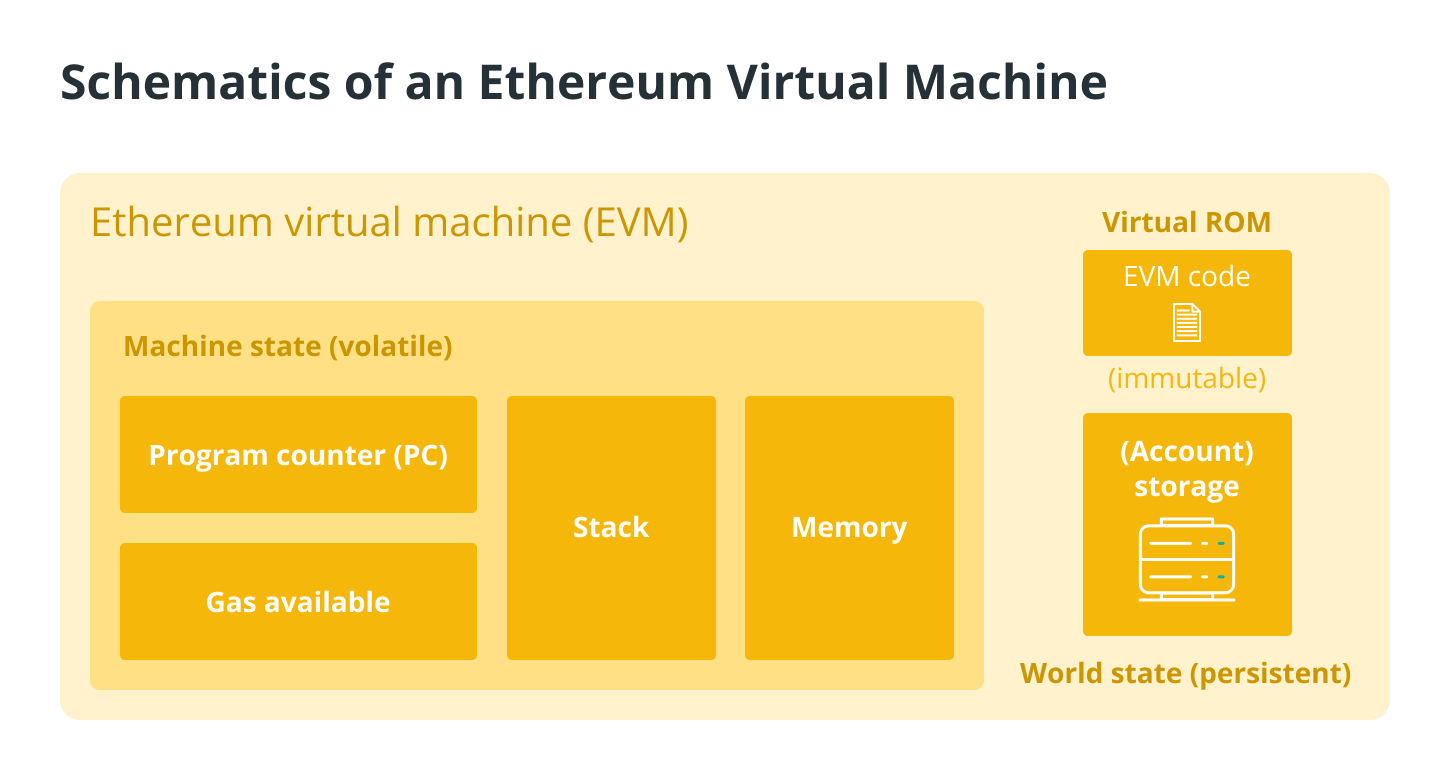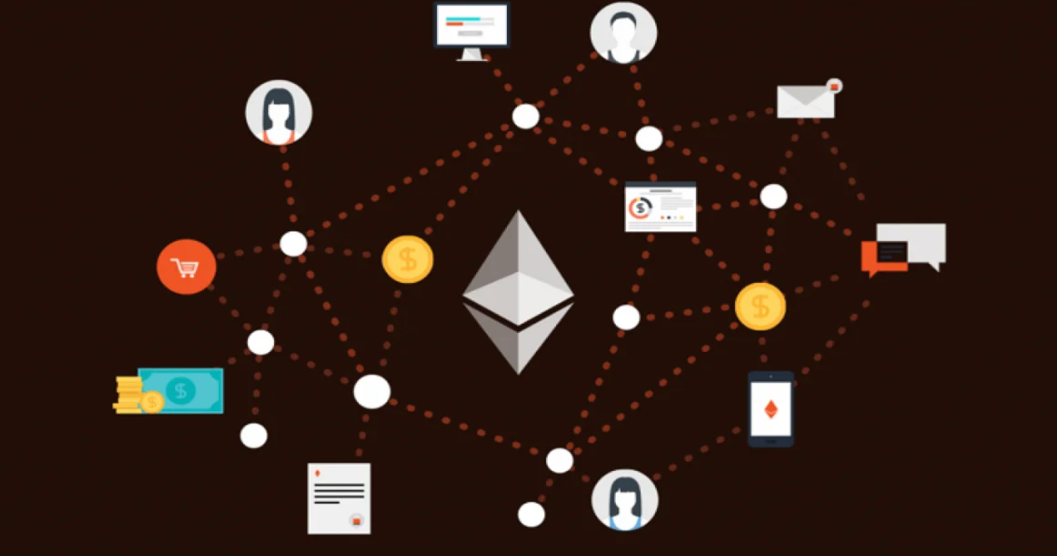
The Ethereum Virtual Machine (EVM) is one of the cornerstones of the Ethereum blockchain. In the simplest of terms, the EVM is like a computer that is responsible for executing smart contracts.
It is an integral part of what makes the Ethereum blockchain a highly innovative project as it provides developers with a platform to deploy immutable codes on the blockchain that have varied use cases across different sectors of the economy from finance to supply chain management.
What is an Ethereum Virtual Machine?

At its core, the EVM functions as a decentralized, Turing-complete virtual machine, enabling the execution of code written in Ethereum’s smart contract programming languages, primarily Solidity.
Its significance lies in its ability to enforce consensus across the network, ensuring that all nodes execute smart contracts identically, thereby maintaining the integrity and immutability of the Ethereum blockchain.
The main feature of the Ethereum Virtual Machine is that it provides an environment for the execution of code that has a fixed standard, meaning it allows interoperability which would mean that it fosters collaboration between different decentralized applications (dApps).
The interoperability factor is very useful for allowing developers to create complex, self-executing agreements which are commonly known as smart contracts.
It is worth mentioning that the EVM typically caters to needs of the interoperability for applications that are built on the Ethereum platform.
While interoperability is a desirable goal for the broader blockchain ecosystem, the EVM primarily operates within the Ethereum network.
Smart contracts are responsible for automating various transactions and processes without the need for any intervention being made from intermediaries, which not only reduces the cost of executing such operations but also provides added features like transparency, security, and efficiency.
The EVM also plays a pivotal role in Ethereum’s economic model through the concept of gas.
Gas incentivizes writing efficient code because each operation in a smart contract consumes gas, and the total gas used determines the cost of executing the contract.
Therefore, writing code that requires fewer computational steps and consumes less gas is more cost-effective for users. Inefficient code that requires excessive computational resources will consume more gas, leading to higher transaction fees and potentially making the contract less attractive to users.
In essence, the Ethereum Virtual Machine (EVM) represents a decentralized computer accessible to everyone. It opens up blockchain technology for programming, allowing individuals and organizations to strive for innovation without needing a central authority.
Within the Ethereum network, the EVM plays a vital role in driving the growth of decentralized finance (DeFi), non-fungible tokens (NFTs), and the broader Web3 movement.
Understanding EVM Architecture

There is a lot of complex architecture in play when it comes to explaining how the Ethereum Virtual Machine (EVM) facilitates the execution of smart contracts on the Ethereum blockchain.
At its core, the EVM comprises several key components that work together with each other to process and execute code in a decentralized and trustless manner.
One fundamental component of the EVM is the Stack, a Last-In-First-Out (LIFO) data structure used for storing temporary data during execution. The stack holds operands for arithmetic operations and function calls, enabling efficient computation within smart contracts.
Another essential aspect of the EVM is its Memory, a linear array of bytes used for storing data during contract execution. Memory is primarily utilized for temporary storage, such as holding function arguments and intermediate computation results.
Additionally, the EVM includes Storage, which acts like a digital filing cabinet. It lets smart contracts keep information on the Ethereum blockchain permanently. Storage is important for holding onto important details and keeping track of data even after many transactions.
The Execution Environment in the Ethereum Virtual Machine is like the operating system for running smart contracts. It consists of different parts, such as the program counter, gas counter, and the current message being processed. The environment also sets limits on gas usage and oversees how resources are distributed while contracts are running.
When a transaction is initiated on the Ethereum network, the EVM processes the associated bytecode, which consists of a series of opcodes representing instructions for the EVM to execute. Each opcode performs a specific operation, such as arithmetic computation, control flow manipulation, or interaction with contract storage.
Overall, the architecture of the Ethereum Virtual Machine is very carefully designed to ensure the secure execution of smart contracts on the Ethereum blockchain.
Bytecode, Opcode, Gas, and Execution

Bytecode, opcode, gas, and execution are integral components of the Ethereum Virtual Machine (EVM), playing crucial roles in the processing and validation of transactions on the Ethereum blockchain.
Bytecode
Bytecode serves as the machine-readable representation of smart contracts deployed on the Ethereum network. It is generated through the compilation of high-level programming languages such as Solidity into low-level EVM instructions known as opcodes.
Opcode
Opcode, short for “operation code,” is a fundamental component of bytecode. Each opcode represents a specific operation or instruction that the EVM can perform.
For example, opcodes can include instructions for arithmetic computations (e.g., addition, subtraction), control flow manipulation (e.g., branching, looping), or interacting with contract storage (e.g., reading or writing data to the blockchain).
Gas
Gas is the unit of computation used to measure the computational cost of executing transactions and smart contracts on the Ethereum network.
Gas ensures that resources are allocated fairly and prevents denial-of-service attacks by imposing a cost on each computational step.
Transactions include a specified gas limit, which represents the maximum amount of gas that can be consumed during execution. Gas costs associated with individual opcodes are predetermined and provide incentives for efficient code execution.
Execution
During execution, the EVM processes transactions by sequentially executing the bytecode associated with smart contracts.
The execution process involves fetching and decoding opcodes, performing the corresponding operations, and updating the state of the contract and the blockchain accordingly.
Gas is consumed as each opcode is executed, and if the gas limit is exceeded before the transaction completes, execution is reverted, and any changes to the contract state are rolled back.
Transaction validation is a crucial aspect of the execution process, ensuring that transactions adhere to the rules defined by the Ethereum protocol. Validators verify transaction signatures, validate transaction parameters such as gas limits and nonce values, and check for sufficient account balances to cover gas costs.
Security and Development Considerations
Security and development considerations are paramount when working with smart contracts on the Ethereum blockchain. While smart contracts offer unparalleled transparency and automation, they also introduce unique security challenges that must be addressed to mitigate risks effectively.
One significant concern is the potential for vulnerabilities in smart contract code. Common vulnerabilities include reentrancy attacks, integer overflow/underflow, and logic errors. Developers must conduct thorough code reviews and utilize tools such as static analyzers to identify and fix potential vulnerabilities before deployment.
To aid in the development process, a variety of tools are available to Ethereum developers. Frameworks like Truffle and Embark provide development environments and testing suites for writing, deploying, and testing smart contracts. Additionally, tools like MythX offer security analysis and vulnerability detection services, helping developers identify and mitigate potential security risks in their code.
In addition to leveraging tools, developers should adhere to best practices to enhance the security of their smart contracts. This includes implementing access control mechanisms, validating user input, and utilizing standardized libraries for common functionality. Furthermore, developers should follow the principle of least privilege, only granting contracts the permissions they require to function.
Auditing by third-party security experts is another crucial step in ensuring the integrity and security of smart contracts. External audits can uncover vulnerabilities that may have been overlooked during the development process and provide recommendations for improving contract security.
By adopting a proactive approach to security and development, Ethereum developers can minimize the risk of vulnerabilities and enhance the overall robustness of their smart contracts, thereby fostering trust and confidence in the Ethereum ecosystem.
Real-World Applications

Real-world applications leveraging the Ethereum Virtual Machine (EVM) and smart contracts span a diverse range of industries, demonstrating the versatility and potential of blockchain technology.
In the finance sector, decentralized finance (DeFi) platforms have emerged as prominent examples of EVM utilization.
DeFi protocols enable users to access financial services such as lending, borrowing, and trading directly through smart contracts, without the need for traditional intermediaries.
Platforms like MakerDAO offer decentralized stablecoins, while Uniswap facilitates decentralized token swaps, revolutionizing the way individuals interact with financial markets.
In the supply chain industry, blockchain-based solutions powered by the EVM enhance transparency and traceability throughout the supply chain process.
Companies utilize smart contracts to track the movement of goods, verify product authenticity, and automate contractual agreements. Projects like VeChain and IBM Food Trust leverage blockchain technology to ensure the integrity and provenance of products from farm to fork, combating issues like counterfeit goods and food fraud.
Gaming represents another possible avenue for EVM-based applications, with the concept of non-fungible tokens (NFTs) gaining traction.
NFTs are unique digital assets that can represent ownership of in-game items, digital art, collectibles, and more.
Games like Axie Infinity leverage smart contracts to create and trade NFTs, allowing players to truly own and monetize their digital assets.
Furthermore, EVM-based solutions are making inroads in areas such as decentralized identity management, voting systems, and intellectual property rights management.
These applications demonstrate the transformative potential of blockchain technology beyond traditional financial use cases, paving the way for a more decentralized and interconnected world.
Future of EVM
The future of the Ethereum Virtual Machine (EVM) holds significant promise but also presents several challenges that must be addressed to unlock its full potential.
One pressing issue facing the EVM is scalability. As the Ethereum network continues to grow in popularity, congestion, and high transaction fees have become obstacles to mainstream adoption.
To address this challenge, Ethereum developers have introduced solutions such as layer 2 scaling solutions like Optimistic Rollups and zk-Rollups. These approaches aim to increase the network’s capacity to process transactions while reducing costs and improving overall efficiency.
While the Ethereum roadmap also included implementing sharding protocols, that idea was later scraped from its roadmap as the developers saw that the performance enhancement introduced by Layer 2 solutions was sufficient enough to scrap the idea of sharding.
For now, they have been focusing on proto-danksharding which according to the latest update was successfully incorporated in the Ethereum Cancun-Deneb upgrade on January 17, 2024.
The Ethereum organization believes that these steps will help improve the scalability of the blockchain and will also help in reducing gas costs as the time required to complete transactions will be reduced in these rollups.
Another area of focus for the future of the EVM is efficiency. Smart contract execution on the EVM can be resource-intensive, leading to high gas costs and slower transaction speeds.
Optimizing the EVM’s execution model and introducing more efficient opcode implementations can help reduce gas consumption and improve transaction throughput.
Additionally, advancements in security are crucial for ensuring the continued trustworthiness of the EVM.
As the complexity of smart contracts increases, so does the risk of vulnerabilities and exploits. Continued research into formal verification methods, enhanced auditing processes, and standardized security best practices can help mitigate these risks and bolster the security of smart contracts deployed on the EVM.
Interoperability with other blockchain networks is another area where the future of the EVM holds promise.
Efforts to bridge Ethereum with other blockchain platforms can expand its reach and enable seamless cross-chain interactions, unlocking new opportunities for innovation and collaboration in the decentralized ecosystem.
Final Thoughts
Overall, the future of the EVM lies in its ability to address current challenges such as scalability, efficiency, and security while embracing opportunities for interoperability and collaboration with other blockchain networks. By continually evolving and adapting to the needs of its users, the EVM can remain at the forefront of blockchain innovation for years to come.




